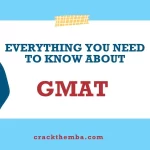What is the rationale for introducing Integrated Reasoning Questions into the GMAT?
Integrated Reasoning questions test candidates’ ability to look at multiple points of data and synthesize it into important business decisions. This skill is valuable in the real world and hence, this new section has been introduced into the GMAT with a view to test candidates in their ability to get rid of the noise and make business decisions.
How many questions will the Integrated Reasoning section have?
The Integrated Reasoning section would comprise of 12 questions.
How much time would I have for the Integrated Reasoning section?
The Integrated Section would be 30 minutes long. In other words, candidates will have 2 minutes 30 seconds to answer each question in this section.
Does a new section mean the time for the test becomes longer?
No. The length of the GMAT remains the same at 3 hours 30 minutes. The 30 minutes for the Integrated Reasoning Section comes from the AWA section as that gets reduced to 1 Essay Question in the new format.
How does the GMAT scoring scale change?
The GMAT will still be scored on a scale of 200-800. The scoring for the different sections within the test will be as given in the table below.
| Exam Section | Score Range | Scoring Intervals |
| Analytical Writing Assessment | 0.0-6.0 | Intervals of 0.5 |
| Integrated Reasoning | 1-8 | Intervals of 1 |
| Quantitative | 0-60 | Intervals of 1 Scores <7 or >50 are extremely rare |
| Verbal | 0-60 | Intervals of 1 Scores <9 or >44 are extremely rare |
| Total Score | 200-800 | Intervals of 10 Scaled from Verbal and Quantitative |
How would the scoring for each question work?
Each question may require more than one response. Candidates must answer all parts of a single question correctly in order to receive credit.
Can I go back and change my answer?
No. Candidates must answer all parts of a question in order to move on to the next screen. Once they advance to the next screen, they cannot go backward.
Will I be allowed to use a calculator?
Yes, use of a basic on-screen calculator will be allowed for the Integrated Reasoning Section, but not for the Quantitative Section.
Candidates are still not allowed to bring calculators to the testing room.
Would I be able to answer a question even if I have not been able to correctly solve for a previous question?
Yes. The Multi-Source Reasoning question type uses the same data source for multiple questions. However, the questions are independent of each other. Candidates do not have to answer one correctly to be able to answer another.
What are the different types of Integrated Reasoning Questions?
- Graphics Interpretation: Interpret the graph or graphical image and select the option from a drop-down list to make the answer statements accurate.
- Two-part Analysis: Select one answer from each column to solve a problem with a two-part solution. Possible answers will be presented in a table with a column for each part.
- Table Analysis: Sort the table to organize the data so you can determine whether certain conditions are met. Each question will have statements with opposing answers (e.g., yes/no, true/false, inferable/not inferable); select one answer for each statement.
- Multi-Source Reasoning: Click on the page to reveal different data and discern which data you need to answer the question.
Sample Integrated Reasoning Questions
(Note: Answers given at the end)
1. Graphics Interpretation

Refer to the pictograph of a survey of students at Central Community College. Each symbol represents 10 students in a sample of 300.
Complete each statement according to the information presented in the diagram.
If one student is selected at random from the 300 surveyed, the chance that the student will be under 30 or a high school graduate or both is:
- 1 out of 6
- 1 out of 3
- 2 out of 3
- 5 out of 6
If one student is selected at random from the 300 surveyed, the chance that the student will be both under 30 and a high school graduate is:
- 1 out of 6
- 1 out of 3
- 2 out of 3
- 5 out of 6
(Note: Answers given at the end)
2. Two-Part Analysis
The following excerpt from a fictitious science news report discusses a fictitious type of location called a morefa.
For zoologists studying the behavior of certain species of birds, the critical importance of observing the birds in those species’ morefa during the annual breeding season is obvious. Such observation allows researchers to study not only the courtship displays of many different individuals within a species, but also the species’ social hierarchy. Moreover, since some species repeatedly return to the same morefa, researchers can study changes in group dynamics from year to year. The value of observing a morefa when the birds are not present, however—such as prior to their arrival or after they have abandoned the area to establish their nests—is only now becoming apparent.
Based on the definition of the imaginary word morefa that can be inferred from the previous paragraph, which of the following activities of a bird species must happen in a location for that location to be the species’ morefa, and which must NOT happen in a location for that location to be the species’ morefa? Make only two selections, one in each column.

